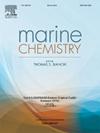地中海东部边缘溶解的微量金属、稀土元素和铅同位素的动态
IF 2.5
3区 地球科学
Q2 CHEMISTRY, MULTIDISCIPLINARY
引用次数: 0
摘要
大陆边缘通过将营养物质和微量营养物质(微量金属)从海岸转移到海洋来支持海洋初级生产力。然而,控制微量金属在陆地-海洋连续体中输送的机制,以及它们如何在时间上变化,仍然知之甚少。在这里,我们报告了在地中海东部的两个样带巡航中溶解的微量金属(Al, Mn, Fe, Co, Ni, Cu, Zn, Cd和Pb),稀土元素(REEs),营养物质(PO4, TON和SiOH4)和Pb同位素的高空间分辨率深度剖面。不同的人为输入导致Zn和Pb浓度和Pb同位素的巡航间变化。相比之下,PO4、SiOH4、Cu和Co的时间变化较小。地中海东部Pb的同位素组成(206Pb/207Pb = 1.161-1.173和208Pb/206Pb = 2.085-2.101)受大西洋平流和大陆径流(陆地)或大气梭子输送的人为输入控制。深水铅存量部分受历史人为源控制。在中黎凡特水域,锌和Cd富集(分别为81%和17%),Pb相对于开放水域减少50%,与陆地Pb同位素特征相一致,稀土元素轻度减少(页岩归一化Nd/Yb <;0.22)和强烈的Ce异常(Ce/Ce* <;0.20)。这些都是由边缘的中间云石层驱动的,这些云石层通过释放和清除充当微量金属的来源和汇,明显距离海岸300-500公里。这项研究强调了大陆边缘在调节陆地和人为对海洋的输入方面的动态作用。本文章由计算机程序翻译,如有差异,请以英文原文为准。
Dynamics of dissolved trace metals, rare earth elements and Pb isotopes across the eastern margins of the Mediterranean Sea
Continental margins support marine primary productivity by transferring nutrients and micro-nutrients (trace metals) from the coast to the oceans. Yet, the mechanisms governing the delivery of trace metals across the land-sea continuum, and how they vary temporally, are still poorly constrained. Here, we report high spatial resolution depth profiles of dissolved trace metals (Al, Mn, Fe, Co, Ni, Cu, Zn, Cd, and Pb), rare earth elements (REEs), nutrients (PO4, TON, and SiOH4) and Pb isotopes from two transect cruises in the oligotrophic eastern Mediterranean Sea.
Varying anthropogenic inputs resulted in inter-cruise variations in Zn and Pb concentrations and Pb isotopes. In contrast, low temporal variability was registered for PO4, SiOH4, Cu, and Co. The isotopic composition of Pb in the eastern Mediterranean Sea (206Pb/207Pb = 1.161–1.173 and 208Pb/206Pb = 2.085–2.101) is controlled by advected Atlantic surface water and anthropogenic inputs delivered via continental runoff (terrestrial) or atmospheric shuttles. The deep-water inventory of Pb is partially controlled by historical anthropogenic sources. An enrichment in Zn and Cd (81 and 17 %, respectively) and a 50 % depletion in Pb relative to open-waters was observed in Intermediate Levantine Waters, in tandem with terrestrial Pb isotopic signatures, light REE depletion (shale-normalized Nd/Yb < 0.22) and a strong Ce anomaly (Ce/Ce* < 0.20). These are driven by intermediate nepheloid layers from the margins, which act as both a source and a sink for trace metals through release and scavenging, evident 300–500 km away from the shore. This study highlights the dynamic role of continental margins in modulating terrestrial and anthropogenic inputs to the oceans.
求助全文
通过发布文献求助,成功后即可免费获取论文全文。
去求助
来源期刊

Marine Chemistry
化学-海洋学
CiteScore
6.00
自引率
3.30%
发文量
70
审稿时长
4.5 months
期刊介绍:
Marine Chemistry is an international medium for the publication of original studies and occasional reviews in the field of chemistry in the marine environment, with emphasis on the dynamic approach. The journal endeavours to cover all aspects, from chemical processes to theoretical and experimental work, and, by providing a central channel of communication, to speed the flow of information in this relatively new and rapidly expanding discipline.
 求助内容:
求助内容: 应助结果提醒方式:
应助结果提醒方式:


